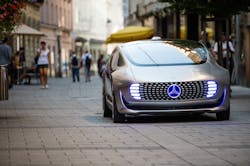Nvidia said that it had built a computer system that could squeeze the processing power required for fully autonomous driving onto a board the size of a license plate. It said that the on-board computer, Pegasus, could run more than 320 trillion operations per second.
Jensen Huang, chief executive of Nvidia, said on Tuesday that the computer packed more than 10 times the processing might of the company’s previous Drive PX system, which is already used by Tesla, Audi, and Volvo to power autonomous highway driving and safety functions like lane-change warnings and emergency braking.
The Pegasus system is capable of processing information from 16 different sensors, including lidar and cameras, to recognize objects around it and pinpoint its position on the road within centimeters. It also provides the raw processing power also track other cars and pedestrians around the vehicle so that it can plot out the safest route to its destination.
Nvidia plans to sells the new system to companies like Nutonomy and Zoox, which are testing autonomous car prototypes. Today, these firms are stuffing cars with what resemble small data centers, equipped with racks of Nvidia’s server chips. But doing that is too expensive, too bulky, and would require too much power of mass-produced cars.
Danny Shapiro, senior director of Nvidia's automotive business, said that the Pegasus system is better suited for production vehicles like taxis that can drive without human intervention and possibly without steering wheels, mirrors, and brakes. "This is the path to production," Shapiro said in an interview with news website Axios.
The Santa Clara-based firm said that it would release the system in the second half of next year. The board is equipped with two graphics accelerators as well as two Xavier chips using Nvidia's new graphics architecture, Volta, which uses special processing cores to solve the complex mathematics used in deep learning.
Nvidia is targeting its graphical processors at “end-to-end” deep learning, in which algorithms learn patterns in data with little human instruction. The company claims that self-driving algorithms can learn to drive within highway lanes, for instance, by watching the road through a front-facing camera for millions of miles.
In addition to autonomous taxis, the Pegasus system could also be used in driverless delivery trucks. On Tuesday, Deutsche Post and its subsidiary DHL said that it would start testing such vehicles next year using Drive PX on-board computers, while also using Nvidia’s server chips for training neural networks. The new system also meets the most stringent safety level for automotive electronics, ASIL-D.
About the Author
James Morra
Senior Editor
James Morra is the senior editor for Electronic Design, covering the semiconductor industry and new technology trends, with a focus on power electronics and power management. He also reports on the business behind electrical engineering, including the electronics supply chain. He joined Electronic Design in 2015 and is based in Chicago, Illinois.

